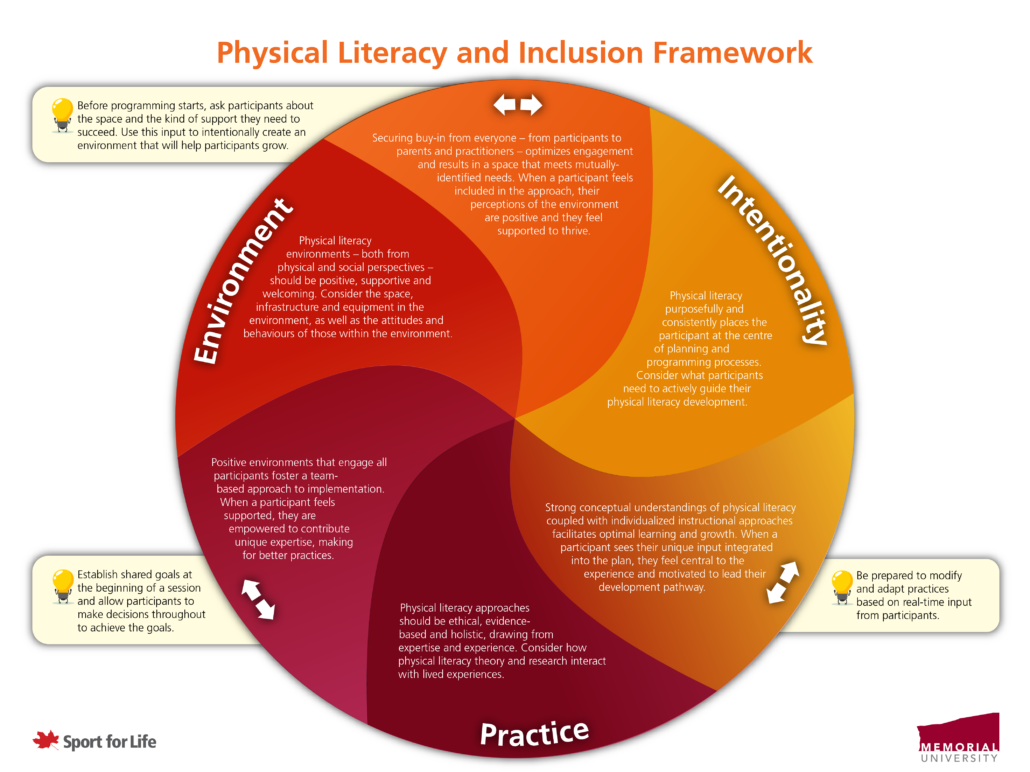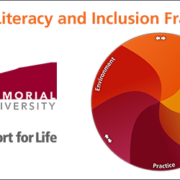Pillars to physical literacy and inclusion: Ongoing education and development for practitioners
Many programs have implemented physical literacy (PL) but often overlook the experiences of persons with diverse abilities due to societal, cultural, and political influences. This can lead to exclusion and marginalization from physical activities. Researchers at Memorial University have addressed this challenge by developing a PL and inclusion framework through direct observation of programming and perspectives from participants of diverse abilities, parents, practitioners, and program administrators. The framework and its three pillars of environment, practice and intentionality offer one lens to support the development of current and future inclusive physical literacy programs.
This blog series will discuss the 10 evidence-based best practices for the inclusion of persons with diverse abilities in programming suggested within their research findings. From holistic design to systems of support, and everything in between, find out how to foster inclusion in your programs.

Idealization: Practitioners must be afforded initial and ongoing opportunities for education, learning, and professional development, aligning with the conceptual, philosophical and operational foundations of physical literacy.
As described in the practice pillar, physical literacy for all is fostered through a commitment to ethical practice grounded in physical literacy philosophy and evidential support; practice is considered holistic and informed.
A team-based approach to instruction, with the conceptual understanding of physical literacy at its core, is important to facilitating physical literacy development for all.
Putting into practice
Imagine a community wellness centre that serves individuals of all abilities, including those experiencing disabilities. The centre’s commitment to fostering physical literacy among its practitioners is evident in its approach:
The centre starts by ensuring that all new practitioners, whether fitness trainers, volunteer practitioners, physical therapists, or recreational therapists, undergo comprehensive training that aligns with the philosophy of physical literacy. During onboarding, practitioners attend workshops and seminars introducing them to physical literacy and its importance in promoting lifelong physical activity. They learn how to apply these principles in their practice by being given the opportunity to interact with others with varying levels of physical ability.
Recognizing that physical literacy is an evolving field, the wellness centre values continuous professional development for its practitioners. They understand that staying current is essential for providing high-quality services. The centre encourages its practitioners to attend regular training sessions, and conferences focused on physical literacy, providing financial support when necessary or bringing in practitioners with specific levels of expertise to deliver workshops. These events expose practitioners to the latest research, trends, and best practices in the field, enabling them to refine their skills continuously.
The wellness centre promotes an integrated approach, where practitioners from various disciplines collaborate to provide holistic support to individuals with disabilities. Regular interdisciplinary meetings and knowledge-sharing sessions between staff and those with a level of authentic lived experience are held to ensure practitioners learn from each other’s expertise. This approach allows for a more holistic understanding of physical literacy and its application in different contexts.
Practitioners undergo a process of continuous and regular reflection on their practice, including evaluating their ability to incorporate physical literacy principles into their work. The centre conducts performance reviews considering how practitioners apply physical literacy in their participant interactions. Constructive feedback is provided, and practitioners are provided with opportunities to reflect on their practice and identify which areas they feel need improvement.
Through a commitment to ongoing education, learning, and professional development aligned with physical literacy, the wellness centre ensures its practitioners remain well-informed and equipped to support individuals with disabilities effectively. This approach encourages long-term physical activity among clients and fosters a culture of excellence within the organization. This example demonstrates how all physical activity service practitioners can ensure the principle of providing initial and ongoing opportunities for education, learning, and professional development aligned with the conceptual, philosophical, and operational foundations of physical literacy. Through continuous training, interdisciplinary collaboration, and a commitment to excellence, practitioners can better serve individuals experiencing disabilities and promote lifelong physical activity.
Tangible takeaways
Here are some suggestions for ways to support your practitioners and staff in learning more about inclusive physical literacy:
- Organize workshops and training sessions: Arrange interactive workshops or training sessions led by experts in inclusive physical literacy. These sessions can cover topics such as understanding diverse abilities, creating inclusive environments, and adapting physical activities for participants.
- Provide online resources: Curate a collection of online resources, including articles, videos, and webinars, focusing on inclusive physical literacy. Make these resources accessible to your team, allowing them to explore and learn at their own pace.
- Collaborate with inclusive sports organizations: Partner with organizations specializing in inclusive sports and physical activities. Invite their representatives to share their knowledge and experiences with your team or arrange joint initiatives to promote inclusive physical literacy.
- Pacific Institute of Sport Education (Victoria)
- Variety Village (Toronto)
- Abilities Centre (Whitby)
- Establish communities of practice: Encourage employees to form peer learning groups or communities of practice. These groups can provide a platform for team members to share their insights, experiences, and best practices related to inclusive physical literacy.
- Encourage certifications and qualifications: Support team members who wish to pursue certifications or qualifications in physical literacy, focused on or with learning opportunities surrounding diverse abilities. If you can, offer financial assistance or time in their work day to enable them to gain specialized knowledge and skills.
- Host guest speakers and panel discussions: Invite guest speakers or experts to address your team on topics related to inclusive physical literacy. Panel discussions can also provide valuable insights and perspectives from practitioners and individuals with lived experiences.
Creating an inclusive environment and promoting physical literacy requires ongoing commitment and effort. By implementing these suggestions, you can actively support your team in gaining knowledge and fostering inclusive practices.
This article is one of a series of posts on the Sport for Life website based on the research conducted by Drs. Kyle Pushkarenko and Jeff Crane of Memorial University. Keep an eye on our blog for information on the 10 suggested best practices and ways to take action around them over the coming months.

